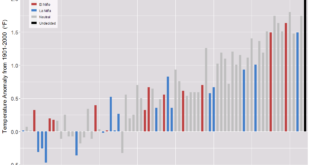
The NOAA article Another Climate Milestone on Mauna Loa (6/7/18) provides an overview of CO2 measurement at the Mauna Loa site. In particular,
Carbon dioxide levels measured at NOAA’s Mauna Loa Atmospheric Baseline Observatory averaged more than 410 parts per million in April and May, the highest monthly averages ever recorded, scientists from NOAA and Scripps Institution of Oceanography at the University of California San Diego announced today.
There is also this point:
From 2016 to 2017, the global CO2 average increased by 2.3 ppm – the sixth consecutive year-over-year increase greater than 2 ppm. Prior to 2012, back-to-back increases of 2 ppm or greater had occurred only twice.
Why Mauna Loa?
The Mauna Loa observatory is ideally located for monitoring CO2 and other greenhouse gases in the atmosphere. Situated at more than 11,000 feet above sea level in the middle of the Pacific Ocean, the site gives researchers the opportunity to sample air that has been well-mixed during its passage across the Pacific and, thanks to its altitude, is minimally influenced by local vegetation or local pollution sources.
The article links directly to CO2 data sets and other resources. The Calculus Projects page here has a Mauna Loa CO2 project and the Misc Materials page has the CO2 movie.
